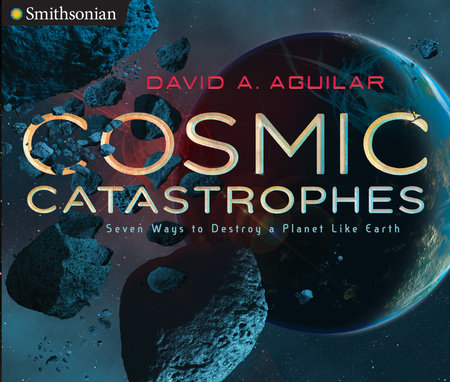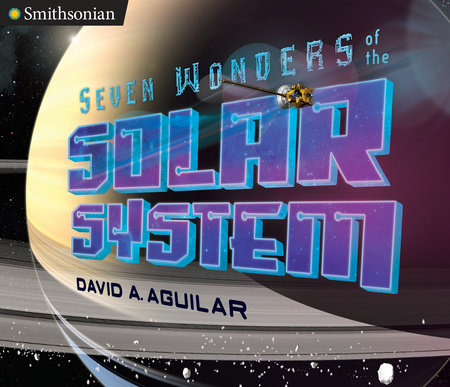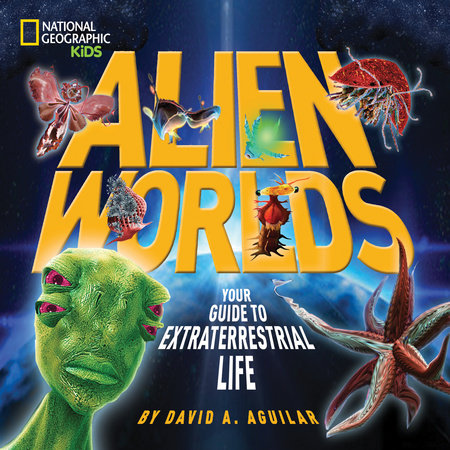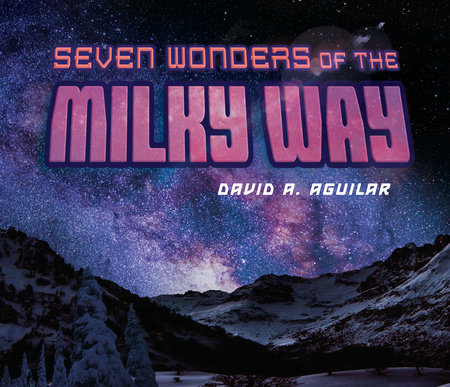Far Out! Author David A. Aguilar On Depicting Never-Before-Seen Outer Space Discoveries for Kids
by the Brightly Editors
“Keep your eye on the sky!” is the advice offered by renowned astronomer David A. Aguilar in Cosmic Catastrophes, his new book for middle grade readers. From alien invasion to asteroids, David explores the vast realm of outer space and the impact interstellar objects could have on our planet. We chatted with David about his lifelong passion for exploring deep space, his process behind creating illustrations of never-before-seen space phenomenon (like aliens!), and how he makes his art look so realistic and cool. Read on for more!
Was astronomy something you were interested in when you were growing up? What’s your favorite space-related topic to discuss with kids?
As a young boy growing up in Northern California, science fiction movies with aliens and flying saucers really excited me, as well as the future exploration of space. I dreamed that someday, I might walk on the surface of the moon. These dreams and desires sent me to my local library where I read everything I could about exploring space from Tom Swift to The Conquest of Space. It was there I discovered books on how to make a telescope. I was hooked! If I couldn’t physically explore outer space, I certainly could do it with a telescope.
to The Conquest of Space. It was there I discovered books on how to make a telescope. I was hooked! If I couldn’t physically explore outer space, I certainly could do it with a telescope.
My favorite space-related topics to discuss with both kids and adults include a host of themes such as the uniqueness of our tiny blue water world with life on it, and asking, “How BIG is the universe?” The universe contains hidden wonders beyond our wildest imaginations and holds the answers to some of the biggest questions: How did the universe begin, will it ever end, and are we alone?
Where do you find inspiration for your “imagined images,” these never-before-seen depictions of space?
I began depicting my “imagined images” of outer space because in my professional field of astrophysics, the discoveries we were making were beyond the capability of instruments like the Hubble Space Telescope to image what astronomers were discovering. We had the data, the graphs, and the charts, but no images to show the world what we had discovered. So I began creating very realistic and scientifically accurate paintings of these marvelous new discoveries. This led to a whole new field of space art that was not based on fantasy. It was based on real facts that helped scientists explore and explain the deepest realms off space.
When I created my book Alien Worlds, it was the result of a television episode I had worked on for the History Channel’s “The Universe” series called “Alien Faces.” Using the latest information from NASA’s Kepler Mission, I selected seven Earth-like worlds that actually exist out there in space and populated them with the type of alien life that explorers from Earth might someday encounter. All the alien forms of life I created were centered on basic principles of biological life we find here on our own planet — however, in these distant alien worlds, their adaptations were more extreme!
On Earth, we have creatures that start out looking one way, go into hibernation, and wake up looking very different. We call this process metamorphosis or “many shapes.” Caterpillars do it when they turn into butterflies. What if alien creatures did the same thing? How strange could that be? In Alien Worlds, I created aliens that undergo astounding changes all based on the physical conditions of their planets, weather, type of star they orbit, temperatures, etc.
Painting in Photoshop is a very cool way to create your art. What made you decide on this medium and how long does it typically take you to finish such complicated paintings?
When I was in grade school, I tried painting with oil paints, watercolors, and later acrylic paints. No matter how long it took to paint pictures of outer space, they always looked like paintings. In later years, I taught myself to paint using the program Photoshop and the results looked as real as if the viewer was actually there in outer space.
When I was younger, I loved building model airplanes, army tanks, ships, and spacecraft. Sometimes, I even built dioramas to display my models. Once, after finishing a model of a Ford tri-motor airplane just like the one Admiral Byrd used to explore the North Pole, I made a diorama in a pizza box by placing the airplane in the middle and sprinkling Tide laundry detergent all around it because it looked just like snow! In later years, I realized I could make models of aliens, or spaceships or even volcanoes on Mars, take a picture of them, and then place it into my painted artwork. So even today, fun things I loved to do as a kid, still bring me great pleasure.
Some paintings may be completed in just a few hours. Others may take days, especially when I’m making models. First I do extensive scientific research on the subject I’m going to paint. I allow myself to daydream about what I want to paint and what it would look like if I were there. Then I sketch my drawings on paper with pencil until the composition looks right. Next, I begin painting on the computer. My images are then evaluated by scientific experts, changes are made, and sometimes I even discard my artwork and start all over again. By this point I may have worked an entire week, or two, to get it right.
In Cosmic Catastrophes, you mention that your books are a result of trying to answer the many “What if?” questions in your head. Do you currently have a question you’re trying to answer?
I have so many wonderful questions running around in my head and I love trying to chase down their answers. How did the Universe begin? How does life start on planets? Are there any aliens out there we will ever be able to talk to? What do bumblebees see when they fly around in the air? What would it be like to smell things like a dog? (Their noses are 40,000 times more sensitive to odors than ours.)
I know these are really BIG or crazy questions, but every day new discoveries are made that bring us closer to the answers. Did you know that right now, there is an area in space where astronomers are receiving strange repeating bursts of energy coming from the same location that we cannot attribute to any known natural phenomenon? These repeating bursts are the same type of patterns we might use to try and communicate with other alien civilizations! Hmm — could we be listening to the first Tweet from space?
The scenarios portrayed in your book might be a little scary to some young readers. What would you say to kids who may worry about these situations becoming realities?
Chaos is a natural part of nature and the universe. On Earth we have tornadoes, hurricanes, floods, earthquakes, tidal waves, erupting volcanoes, wars, famine, and now climate change that we have to deal with. Our planet was hit by an asteroid that wiped out the dinosaurs. In the past, Earth froze over like a big snowball and we have had ice ages that covered most of Europe and North America, and erupting volcanoes that wiped out more than 80% of all life on land and in the oceans. In my book I am very clear that some of these events have taken place in the past and may happen again someday, in the very distant future. In the vastness of space, many of these catastrophes are happening right now on other alien worlds.

By studying these common cosmic happenings, we may be able to prevent some of these catastrophes happening in our future. So, it is actually a very positive message: Become a scientist and learn about past events to help prevent them from happening to us in the future — and of course, if a young reader has questions or concerns, ask your parents. Ask your science teachers. This is nature, this is life, this is how the universe works!
What resources would you recommend for kids interested in learning more about astronomy? Are there any other space books you’d recommend?
I would suggest checking out from the library and watching DVD copies of TV programs like “NOVA” and from the Discovery Channel and the History Channel to begin with. Many of the astronomy books on the shelves today are quite dated because of all the recent discoveries taking place, but my next book due out spring 2017, Seven Wonders of the Solar System, includes the latest new information on Pluto from the recent New Horizons Pluto encounter mission and on the mysterious Planet 9, the hidden giant ice world astronomers are searching for at the fringes of our solar system.
And we have to ask: Do you believe that aliens exist?
Yes, I do believe there are other forms of life out there in the universe. However, I do not think they will look like the aliens in “Star Trek” or “Star Wars” movies. They will be bizarre forms of life that we may never be able to communicate with, or even understand. They may sense the universe differently than we do, visually see things differently, and have tools and technologies that would seem like magic to us. The universe is so vast and old, it will be teeming with life … there will be worlds crawling with creatures that are aware of their environment, take in food for energy, reproduce more creatures like themselves, and respond when somethings “threatens” them. Most of all, we should probably think of the outer space this way: In this Universe, all of us are aliens!
-
Books by the Author:
-
Seven Wonders of the Solar System
Also available from:
David Aguilar is an astronomer, artist, author of several notable books on space for children, including Cosmic Catastrophes: Seven Ways to Destroy a Planet Like Earth. He is the former Director of Science Information for the Harvard-Smithsonian Center for Astrophysics. As a member of the New Horizons Spacecraft Team, he handled the media coverage of the Pluto fly-by. He lives with his wife outside Aspen Colorado, where he’s built his own observatory. Asteroid 1990 DA was named in his honor by the International Astronomical Union. Read more about the author at davidaguilar.org.









